Are sales and marketing like oil and water?
If your teams don't work well together, driving growth is nearly impossible.
To help solve this age-old problem, we asked the Leadfeeder marketing team to share their alignment best practices.
The good news? It's not more meetings. 🎉
It's better meetings — and getting on the same page when it comes to analytics.
First things first — you need to figure out why your teams are misaligned.
According to Daire Summerville, the Head of Growth Marketing here at Leadfeeder, the majority of misalignment comes from "teams focusing on different metrics and not being aligned around a common goal."
Anna Nabiullina is the Demand Generation Manager at Leadfeeder. She's responsible for generating leads from ABM for several of our outbound sales teams. She finds the majority of misalignment happens "when we aren’t looking at the same reports."
See, you don't need more meetings! 📅
Here's the thing — sales and marketing are a lot like a band. By themselves, the drums and the guitar are fine but put them together and they make amazing music.
Or, you know, drive revenue.
Okay, I'm done with the metaphors. Let's talk about how to get sales and marketing in perfect alignment with easy best practices.
Note: Leadfeeder delivers sales and marketing insights to power ABM strategies, find new leads, and drive demand. Sign up for a free trial.
Sales and marketing alignment best practices from the Leadfeeder marketing team
One of the biggest complaints from sales is they lack relevant data or material from marketing. Marketers often report sales teams aren't clear about their needs and don't follow up with materials in a timely fashion.
It's an age-old conflict — but one that needs to be settled. Here's what our LinkedIn following thinks:
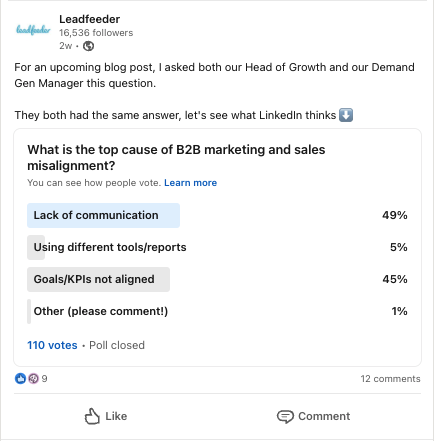
Getting everyone on the same page isn't easy, but it's worth the effort to drive growth and (most importantly, let's be honest,) increase your bottom line.
Here are five best practices to create sales and marketing alignment. ⬇️
Meet regularly
I know, I swore this wouldn't be about more meetings — and it isn't. (Unless sales and marketing never meet, in which case, yes you should have more meetings.)
Rather than meeting more often, make sure the meetings you do have are actually productive.
Have a plan, share specific data, and take the time to get to know what the other team has in the pipeline and what they've done already.
For example, did marketing launch a new initiative? Did that impact SQLs? There's only one way to know — ask.
Daire says,

Anna agrees with ensuring meetings are actionable. She shares,
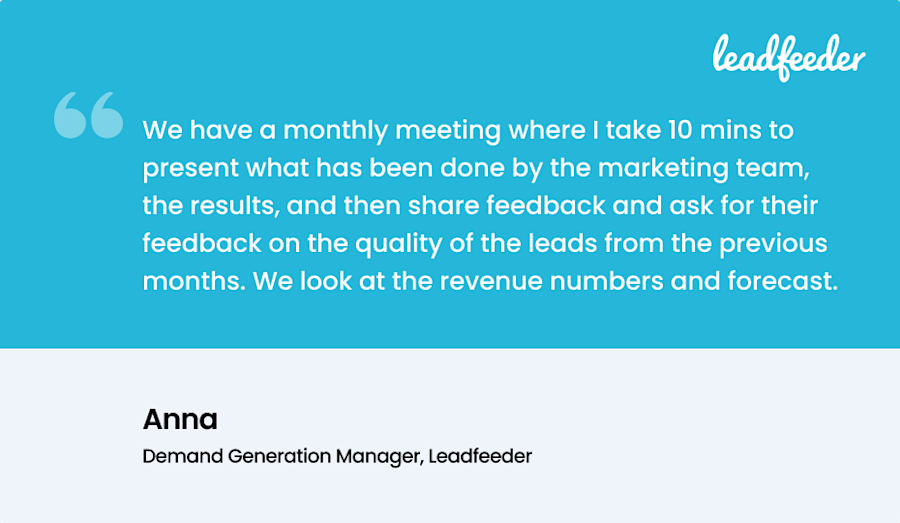
The point here isn't to meet five times a week — it's to make sure the meetings you do have actually provide value.
What does your team care about? Why does that matter? Do those KPIs match what the other side is looking at? If not, you don’t have that coveted sales and marketing alignment.
Agree on KPIs
Another area of contention between sales and marketing is KPIs. Marketing might track metrics like MQLs while sales track SQLs. Are those the same things?
Obviously, they aren't exactly the same thing, but they should be in the same ballpark.
What metrics are most important to your team? Why do those metrics matter? Both teams should be open about sharing the metrics they track and (most importantly) why those metrics matter.
For example, if a new marketing initiative sees a 2,000 percent increase in organic traffic they might think it's a success. But sales might have noticed a very small increase (or none at all) in SQLs. Unless they share data, they won't know.
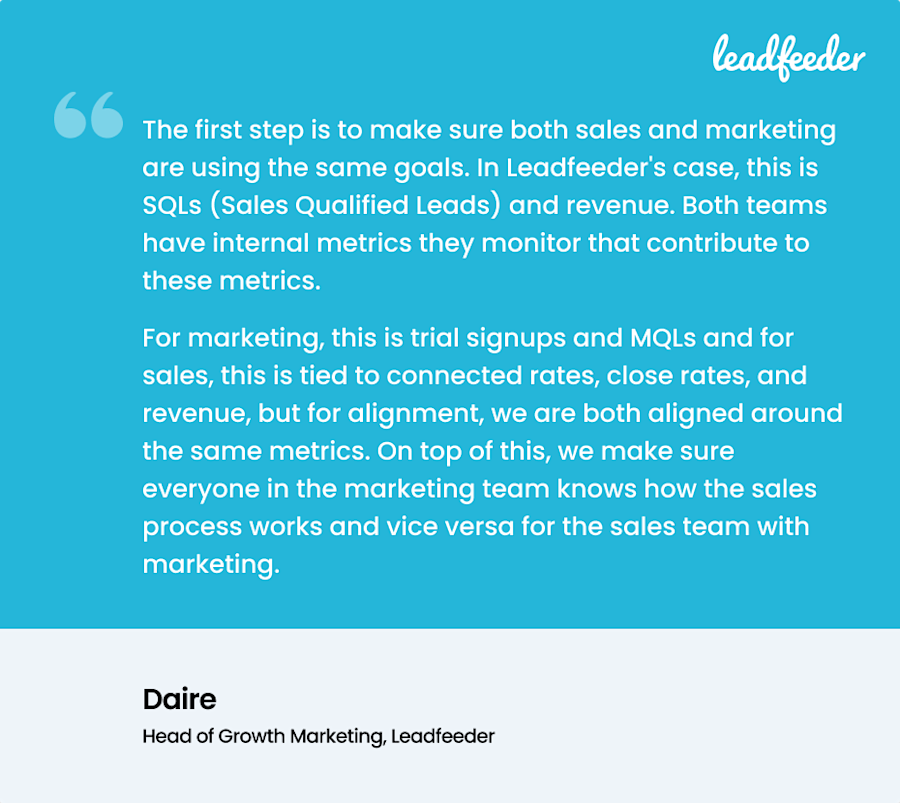
The more both teams understand which data the other team looks at, the easier it will be to work together.
It's pretty easy to do this in Leadfeeder, where both teams have access to the same dashboard and can see the same data about each prospect.
Create a single source of truth for data
Getting on the same page when it comes to data is crucial to sales and marketing alignment. Suppose marketing looks at conversions in one platform while sales tracks conversions in another. They might see drastically different numbers — and decide on very different strategies as a result.
Rather than allowing everyone to pull data all willie nillie create a single source of truth for both sales and marketing data. That means one platform that both teams look at as the gold source for data.

Looking at the same data makes it easier to make the right decision at the right time.
The best way to do this? Integrate all your tools. Leadfeeder, for example, can integrate with your CRM, email platform, even Slack. Most tools can integrate directly or by using Zapier.
Which platform you choose as your single source of truth isn't important, really. What matters is that everyone knows where to go.
Agree on a communication channel or method
When you need to talk to sales or marketing, where do you go? If you're leaving notes in the CRM but sales is using the Leadfeeder dashboard, you're going to miss stuff.
Ideally, you want a single communication channel, something like Slack, your CRM, or even good old email if that's your thing.
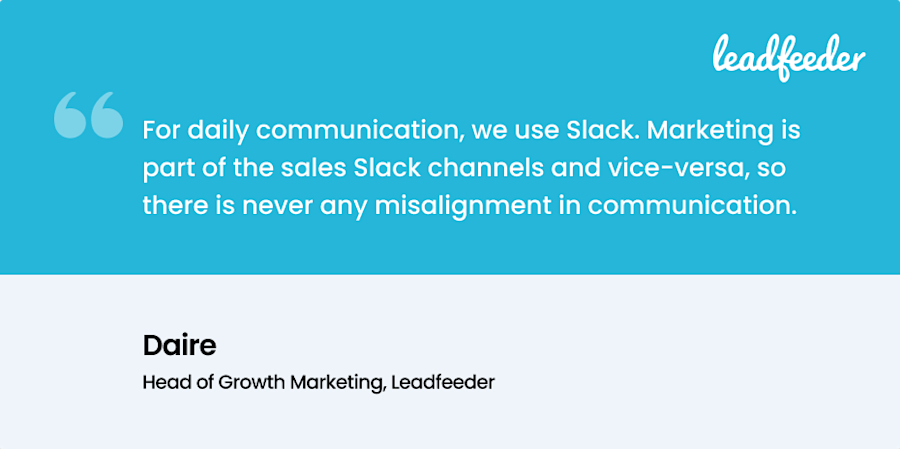
Too many messages can get overwhelming, so create different channels for different topics or campaigns.
For example, you might have one channel for a specific campaign, another for all sales and marketing folks, another for just marketing.
The point is to make sure everyone is on the same page and knows where to go for the information they need.
Integrate platforms whenever possible
We touched on this a little already, but it bears its own point, IMO. Integration is crucial if you want to align both the messaging and timing of sales and marketing.
By connecting the tools that gather customer and prospect data, marketing and sales gain deeper insights that lead to cohesive messaging across the buyer's journey and identify customer subsets that might be high priority or even previously ignored.
For example, integrating Leadfeeder with Salesforce (or whatever other CRM you use) allows you to connect website visitors with current deals in progress. Sales can then see when a lead they're keeping an eye on reads a new blog post then looks at your pricing page. That kind of data helps sales know when prospects have higher intent.
Leadfeeder integrates with a ton of other tools, including Zapier, so you can pull all that sweet, sweet data together.
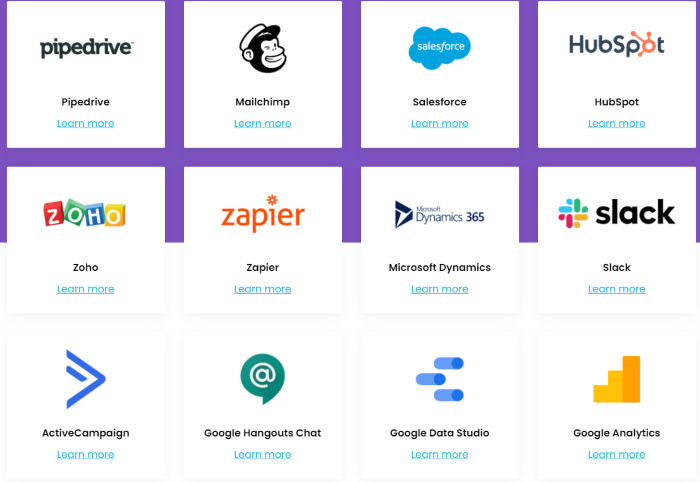
Connecting tools like Slack, email marketing platforms, and Google Analytics means that sales and marketing have access to each other's data, allowing each team to work together in harmony.
Leadfeeder brings sales and marketing into alignment
Sales and marketing alignment isn't just another buzz phrase you can ignore. (looking at you, smarketing.) It's a fundamental shift in how sales and marketing work — and it's crucial for B2B strategies like account-based marketing and demand generation.
Sales and marketing can no longer be siloed teams that meet once a month to talk in circles. Sales and marketing alignment means both teams know what's happening in each step of the funnel, track the same (or mostly the same) KPIs, and communicate regularly.
Note: Leadfeeder is a sales and marketing tool that uncovers hidden leads and tracks the impact of outreach. Sign up for a free trial and see how beautiful sales and marketing alignment can be.
Now that you're here
Leadfeeder is a tool that shows you companies that visit your website. Leadfeeder generates new leads, offers insight on your customers and can help you increase your marketing ROI.
If you liked this blog post, you'll probably love Leadfeeder, too.
Sign up






